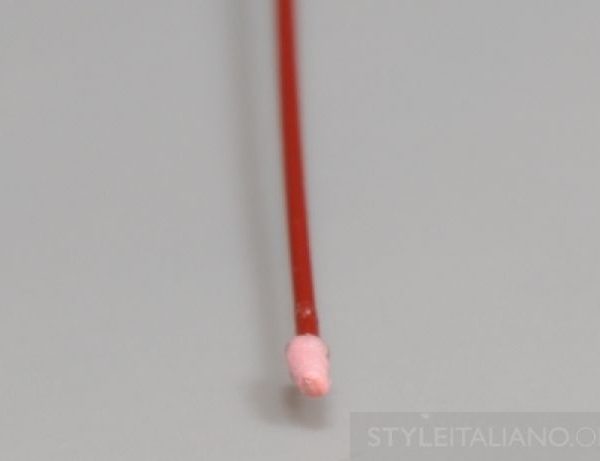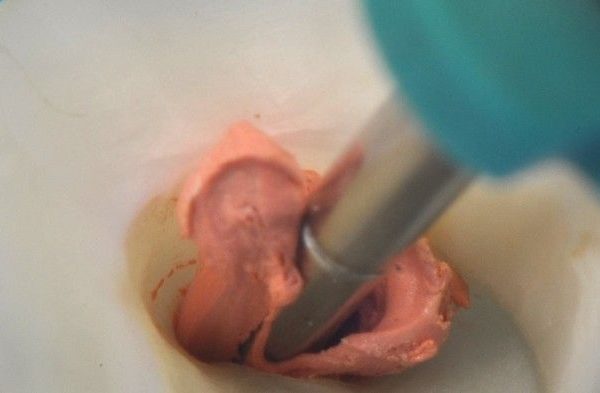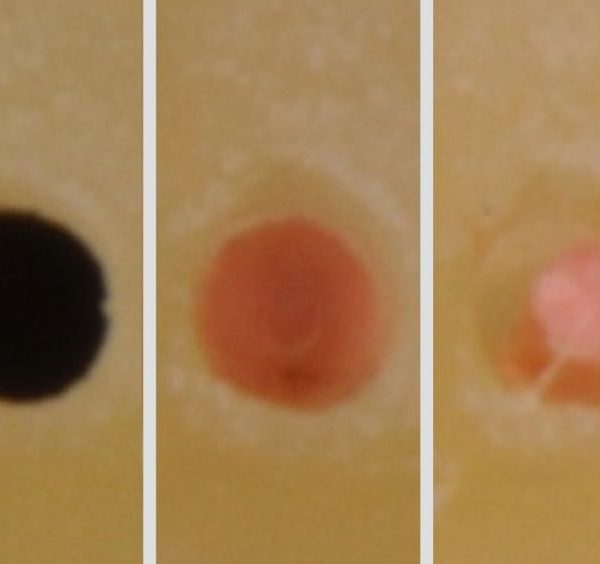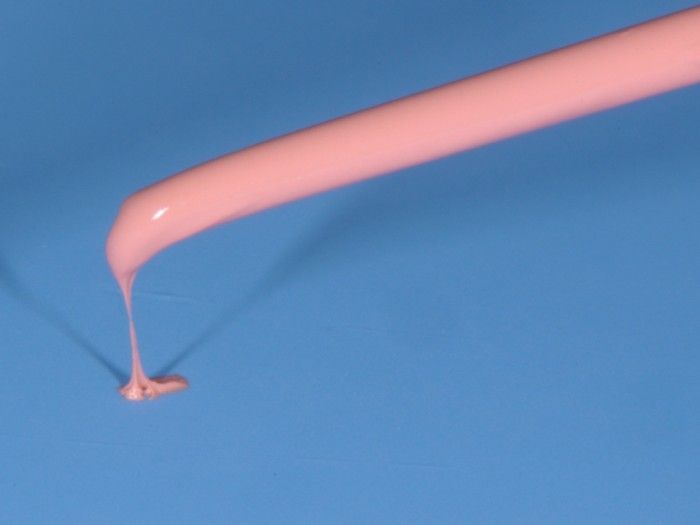
THERMAFIL: The technique step by step
17/02/2017
Enrico Cassai
Warning: Undefined variable $post in /var/www/vhosts/styleitaliano-endodontics.org/endodontics.styleitaliano.org/wp-content/plugins/oxygen/component-framework/components/classes/code-block.class.php(133) : eval()'d code on line 2
Warning: Attempt to read property "ID" on null in /var/www/vhosts/styleitaliano-endodontics.org/endodontics.styleitaliano.org/wp-content/plugins/oxygen/component-framework/components/classes/code-block.class.php(133) : eval()'d code on line 2
Thermafil obturation technique was designed and presented by Dr. Ben Johnson ("A new gutta-percha technique. J Endod 1978), as a simple method for the delivery of thermoplasticized gutta-percha to the prepared root canal. Initially, this system relied on metallic carriers covered by a uniform layer of α phase gutta-percha, intended to be heated over an open flame and inserted in the root canal, already dried and treated with a small amount of sealer. The reported advantages of Thermafil include: apical sealing ability, a short of learning curve, length control, conservative enlargement of root canals. The Thermafil system has since been overhauled and improved, introducing plastic carriers, dedicated ovens, and even cross-linked gutta-percha cores.
The Thermafil armamentarium consists of a series of components, such as:
- Thermafil Obturators
- Thermaprep Oven
- Verifiers
- Dedicated Burs
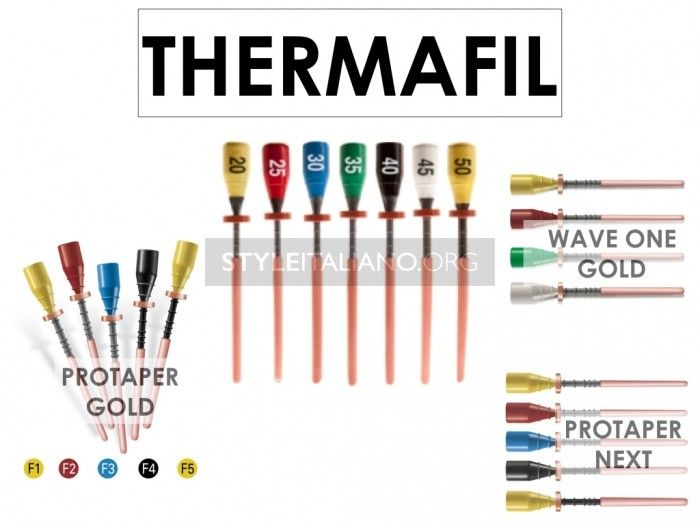
Fig. 1
THERMAFIL Thermafil obturators consist of a core of radiopaque plastic central (carrier) wholly surrounded by a uniform layer of guttapercha. The carrier is distinguished by the colored handle (indicates the diameter of the tip of the carrier according to the ISO standardization) and has a length of 25 mm; It has a longitudinal groove that has the function to increase the flexibility and to facilitate removal.
The positioned circular projections, respectively at 18, 19, 20, 22 and 24 mm from the tip, are useful references for the penetration into the canal. The Thermafil obturators are available in 17 sizes, from 0.20 to 1.40 mm in the tip diameter, with shape of about 4% . Recently, Thermafil obturators, suitable for various shaping protocols, such as Protaper Universal, Protaper Next, Protaper Gold and Wave-One have been proposed.
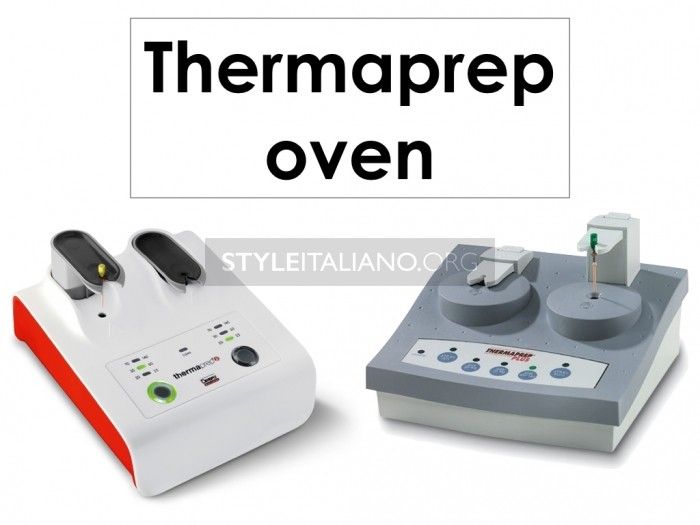
Fig. 2
Thermaprep oven meets the heating requirements of Thermafil obturators, through the production of heat by Joule effect.
The OLDEST version (right) allows the heating of only one obturator at a time, without soft-released button. It is suggested to select the maximum heating program for all the different types of obturators.
The NEWEST version (left) provides simultaneous heating of two obturators in selected programs, and the release-controlled damper. Select the right diameter corresponding to the obturator button and activate the start button to warm the gutta-percha.
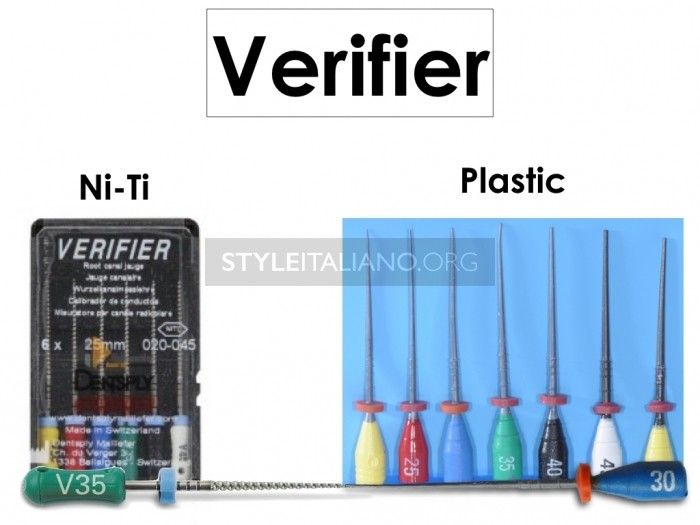
Fig. 3
NI-TI VERIFIER Thermafil verifiers are made of Ni-Ti alloy, in 12 sizes with diameter from 0.20 to 0.90 mm tip and taper of 5%, slightly higher than that of the plastic carrier (about 4 %). They are similar to manual Profile with blunt tip and blades with radial cutting lands; therefore, they can be used for small refinements. PLASTIC VERIFIER The plastic carrier(taper about 4%), stripped of the gutta-percha coating, allows to exactly evaluate the adaptation to the canal, without the risk of production of smear layer.
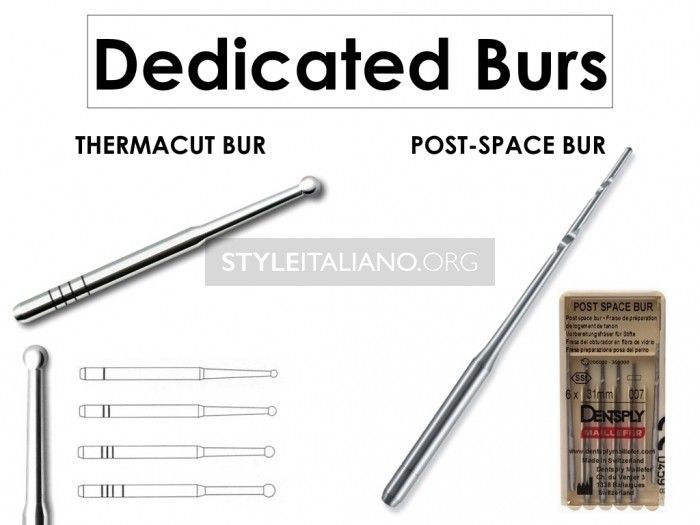
Fig. 4
THERMACUT BUR The Thermacut burs for turbine are made of stainless steel with a smooth spherical tip. The cutting action on the carrier is exercised by the heat produced by friction (designed to work dry). They have a standard length of 25 mm and are produced in 4 different diameters. POST-SPACE BUR The Post-Space burs for turbine are steel cutters for the preparation of the canal for the post after obturation with the Thermafil technique. Available in two diameters with a length of 25 or 31 mm, these smooth burs have a rounded tip. Two transverse grooves along the stem allow depth control. Being used dry, the heat produced by the friction can quickly remove both the carrier and gutta-percha to the desired depth.
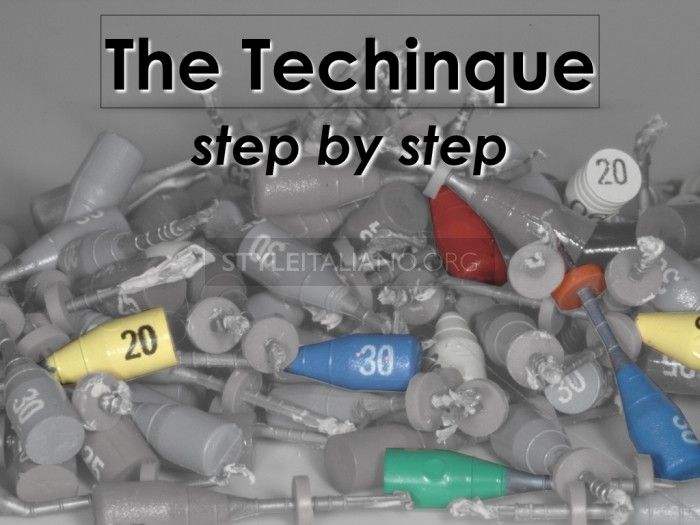
Fig. 5
The sequence to achieve a perfect root canal filling with the Thermafil systematic will be described below:
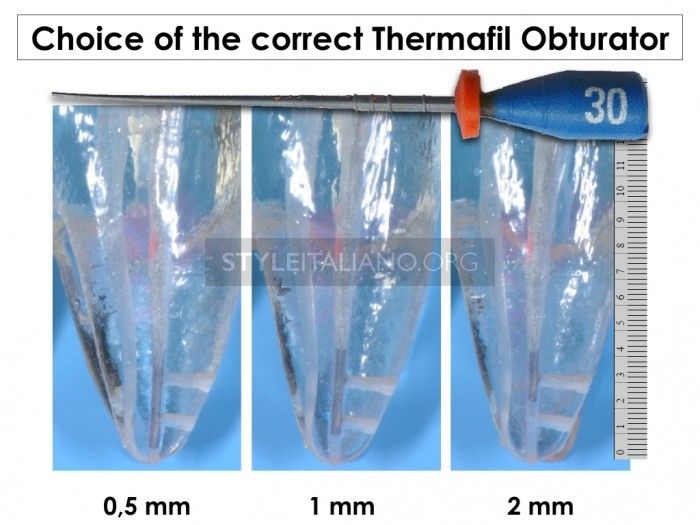
Fig. 6
The easiest way is to use the plastic carrier stripped of the gutta-percha: it will be in fact the one corresponding to the carrier measure, which stops most 0,5-1 mm shorter than the working length, to allow the filling of guttapercha and the cement at the third apical and increase the tightness of the seal. In the presence of a still wet canal (not Hypochlorite!) choose the verifier corresponding to the last finishing file used.
The correct verifier is the bigger one that stops at 0.5-1 mm from the apex.
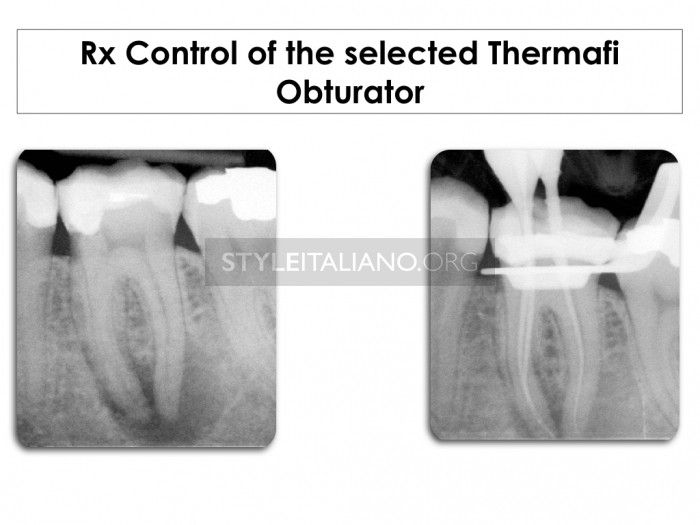
Fig. 7
The position and the adaptation of plastic carrier should be verified by a periapical radiography. If the obturator is not in the correct position, check again the final shaping and / or the choice of the correct obturator.
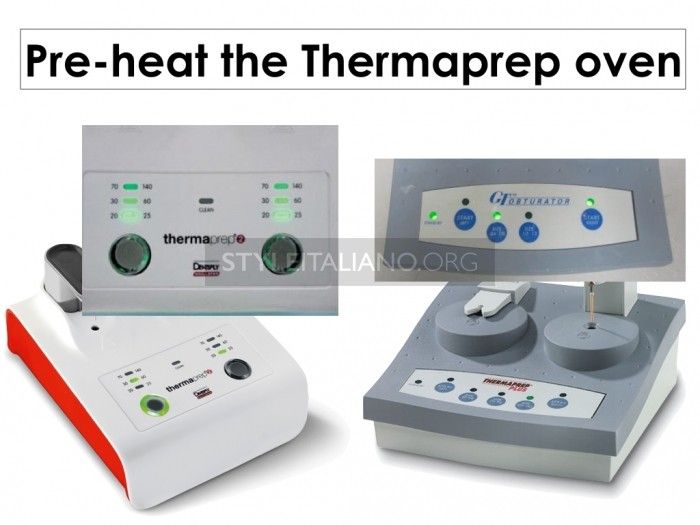
Fig. 8
Preheat the Thermaprep oven, to reduce the waiting times and to get a more homogeneous heating.
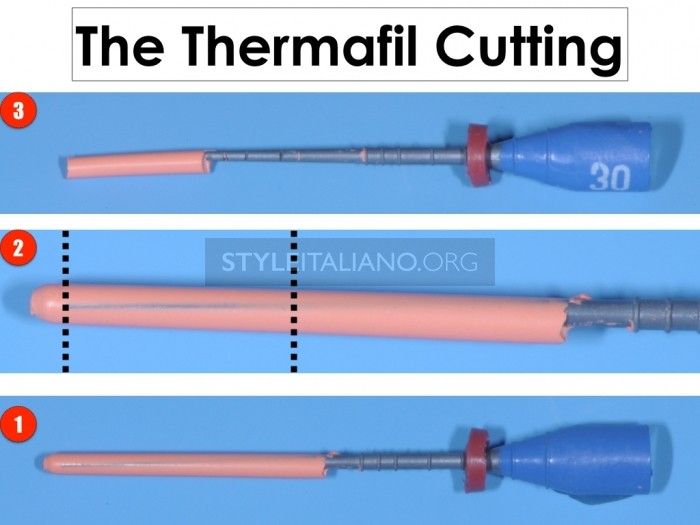
Fig. 9
The quantity of gutta-percha which surpasses the tip of the carrier is variable. So, it is better to remove, with a scalpel blade, a part of gutta-percha from the tip, to make the carrier visible. This prevents the risk of extrusion beyond the apex.

Fig. 10
The Thermafil technique involves the use of small quantities of sealer, to prevent the risk of overfilling.
There are two main techniques to introduce the sealer into the canal:
1. Only the coronal third of the canal is coated with a small amount of sealer
2. TECHNIQUE OF 3 CONES: the sealer is placed in the canal with a paper point, and the excess removed with other 2 paper points to obtain a film of cement around the dentinal wall placed a few mm shorter than the correct working length.

Fig. 11
Insert the selected Thermafil Obturator, with the rubber stop positioned, below the fork of Thermaprep oven.
Push the fork in the heating station, select the maximum program (THERMAPREP OLD MODEL) or dedicated program ( THERMAPREP NEW MODEL).
Wait until the light signal from fixed becomes flashing and is accompanied by a beep.

Fig. 12
The Thermafil obturator, once heated in the oven, is introduced slowly into the canal with small excursions hourly and counterclockwise, until it reaches the preset length (in about 3 sec). The Obturator must be held under slight pressure for 8-10 seconds before being sectioned at the orifice. If, during the operating sequence, problems arise, such as early cooling of the guttapercha, or impossibility to reach the working length, it is appropriate to stop and take an x-ray, with the carrier still intact. If an error had happened, it would be easy to remove the failed obturator and to repeat the filling procedure, successfully.

Fig. 13
Before cutting the Thermafil, it is recommended to check radiographically the correct position of the obturator, and the appropriate working length. With the handle still in place, it is easy to remove the plastic carrier, reshape and fill the canal again.

Fig. 14
The Thermafil Obturator should be cut at the canal orifice.
This operation can be performed with:
- Thermacut dedicated bur
- Plugger 600 ° System-B
- Ultrasonic tip

Fig. 15
Conclusions
The Thermafil system is one of the more predictable and effective methods to obtain a correct filling of the complex three-dimensional root canal system, and is one of the few that allows to convey warm gutta percha directly at the apex. It has proved very effective especially in narrow, long and curved canals, where is difficult to deliver a heat carrier or a plugger in the last 4 mm of the canal in order to properly heat gutta-percha cones.
Bibliography
Cantatore G,CochetJY.Lesyste`meThermafil.RevFrEndod 1998;4(17):3549.
Cantatore G. Thermafil versus System B. Endod Pract 2001;4(5): 309.
cleaning and sterilizing the endodontic system. Re ?alite ?s Cliniques 2001;12(2):185201.
Dalat DM, Sp ?angberg LS. Comparison of apical leakage in root
canals obturated with various gutta-percha techniques using a dye vacuum. J Endod 1994;20(7):3159.
DuLac KA, Nielsen CJ, Tomazic TJ, Ferrillo Jr PJ, Hatton JF. Comparison of the obturation of lateral canals by six techniques. J Endod 1999;25(5):37680.
Dummer PM, Lyle L, Rawle J, Kennedy JK. A laboratory study of root fillings in teeth obturated by lateral condensation of gutta-percha or Thermafil obturators. Int Endod J 1994;27(1): 328.
Fan B, Wu MK, Wesselink PR. Leakage along warm gutta-percha fillings in the apical canals of curved roots. Endod Dent Traumatol 2000;16(1):2933.
Frajlich SR, Goldberg F, Massone EJ, Cantarini C, Artaza LP. Comparative study of retreatment of Thermafil and lateral condensation endodontic fillings. Int Endod J 1998;31(5):3547.
Gilbert SD, Witherspoon DE, Berry CW. Coronal leakage following three obturation techniques. Int Endod J 2001;34(4):2939.
Goldberg F, Artaza LP, De Silvio A. Effectiveness of different obturation techniques in the filling of simulated lateral canals. J Endod 2001;27(5):3624.
Goldberg F, Massone EJ, Esmoris M, Alfie D. Comparison of different techniques for obturating experimental internal resorptive cavities. Endod Dent Traumatol 2000;16(3): 11621.
Gulabivala K, Holt R, Long B. An in vitro comparison of thermo- plasticized gutta-percha obturation techniques with cold lateral condensation. Endod Dent Traumatol 1998;14(6):2629.
Ha ??kel Y, Freymann M, Fanti V, Claisse A, Poumier F, Watson M. Apical microleakage of radiolabeled lysozyme over time in three techniques of root canal obturation. J Endod 2000;26(3): 14852.
Hata G, Kawazoe S, Toda T, Weine FS. Sealing ability of thermo- plasticized gutta-percha fill techniques as assessed by a new method of determining apical leakage. J Endod 1995;21(4): 16772.
Johnson WB. A new gutta-percha technique. J Endod 1978;4: 1848.
Juhlin JJ, Walton RE, Dovgan JS. Adaptation of Thermafil com- ponents to canal walls. J Endod 1993;19(3):1305.
Kim S. Color atlas of microsurgery in endodontics. New York: WB Saunders Company; 2001. p. 114.
Leung SF, Gulabivala K. An in-vitro evaluation of the influence of canal curvature on the sealing ability of Thermafil. Int Endod J 1994;27(4):1906.
Becker TA, Donnelly JC. Thermafil obturation: a literature review. Gen Dent 1997;45(1):4655.
Weller RN, Kimbrough WF, Anderson RW. A comparison of thermo- plastic obturation techniques: adaptation to the canal walls. J Endod 1997;23(11):7036.
Pommel M, Camps J. Effects of pressure and measurement time on the fluid filtration method in endodontics. J Endod 2001;27(4): 2568.
Pommel M, Camps J. In vitro apical leakage of system B compared with other filling techniques. J Endod 2001; 27(7):44951.
Pommel M, Jacquot B, Camps J. Lack of correlation among three methods for evaluation of apical leakage. J Endod 2001;27(5): 34750.
Pathomvanich S, Edmunds DH. The sealing ability of Thermafil obturators assessed by four different mikroleakage techniques. Int Endod J 1996;29(5):32734.


